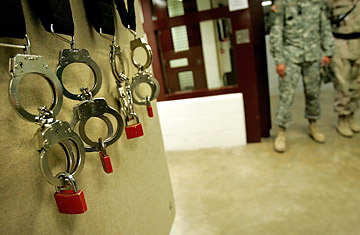
Handcuffs hang inside the maximum-security Camp Delta at the Guantánamo Bay Naval Base
Even before the Aug. 24 release of the 2004 CIA inspector general's report revealed the full extent of harsh methods used on terror detainees, much of the furor over the agency's enhanced interrogation techniques has been over questions of morality, legality and politics. But there's also a cold, practical question: Did harsh methods like waterboarding cause terrorist suspects to give up valuable, actionable information?
The program's defenders, most notably former Vice President Dick Cheney, have long claimed that "high-value detainees" like al-Qaeda operatives Khalid Sheikh Mohammed, Abd al-Rahim al-Nashiri and Abu Zubaydah, initially resistant to interrogation, broke down under the coercive techniques and gave up crucial tips. The information they supplied, Cheney and other defenders have argued, helped to foil specific, imminent terrorist plots against the U.S. homeland, and thus saved thousands of American lives.
In April, after the Obama Administration released the Bush Administration's so-called torture memos, which provided the legal rationale for the tactics, Cheney demanded that it also release two CIA memos that, he said, would "show the success of the effort." Those memos, taken together with the unclassified inspector general's report into the CIA's interrogation program, would be the smoking gun that proved, once and for all, that harsh interrogation paid off.
But a close reading of all three documents, released the same day that the Justice Department announced it would open up a limited investigation into the interrogations, reveals not smoke but fog. And there's just enough of it that both defenders and critics of the CIA's techniques can claim to have been vindicated. The three high-value detainees who endured the harshest interrogation did yield a trove of information, including details of some schemes to attack U.S. targets. But it's hard to gauge whether these were actually looming threats.
The inspector general's report says it "did not uncover any evidence that these plots were imminent." The CIA memos say information gained from detainees led to "arrests [that] disrupted attack plans in progress" — but stop short of attributing this directly to the enhanced interrogations.
What makes a definitive analysis difficult is the fact that the inspector general's report and both memos are, despite their declassification, still substantially redacted. One consequence is that it is hard to establish timelines: for instance, how much information did Khalid Sheikh Mohammed provide before he was waterboarded, and how much afterward? (Mohammed was waterboarded 183 times, Zubaydah 83 times and Nashiri twice.)
Another, more fundamental question hard to answer with certainty is whether the interrogators needed to use harsh techniques at all. The inspector general's report says that at least in some instances, they were used "without justification." Even interrogators in the field worried that their bosses' "assessments to the effect that detainees [were] withholding information [were] not always supported by an objective evaluation, but are too heavily based, instead, on presumptions of what the individual might or should know." But ultimately, the conclusion of the inspector general's report in this regard is not, well, particularly conclusive: "The effectiveness of particular interrogation techniques in eliciting information that might not otherwise have been obtained cannot be so easily measured," the report states.
Whether or not the harsh techniques loosened their tongues, the three men did give up a great deal of information. One of the CIA memos, dated July 13, 2004, described Mohammed as "a key intelligence source for the U.S. government on al-Qaeda plots and personalities." It says he provided "information on al-Qaeda strategic doctrine, probable targets, the impact of striking each target, and likely methods of attacks inside the [U.S.]"
Mohammed told interrogators about plans to crash an airliner into "the tallest building on the West Coast" and to set off bombs at "high-rise buildings in unspecified apartment buildings," as well as plots to target gas stations, railroad tracks and New York City's Brooklyn Bridge.
The other CIA memo, dated June 3, 2005, claims Mohammed divulged crucial information about a plot to crash commercial airliners into Heathrow airport. But the same memo notes that "uncharacteristic for most detainees, [Mohammed] almost immediately following his capture, elaborated on his plan to [attack Heathrow]." This could suggest he gave up the information before he was put on the waterboard. But as with much of the eagerly anticipated documents, its meaning is anything but clear. Which means that far from ending the debate on whether harsh interrogation worked, the inspector general's report and CIA memos have simply provided more grist to both sides of the argument.
